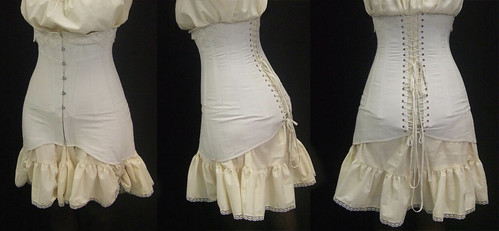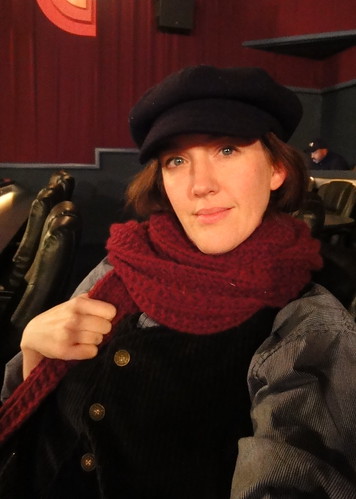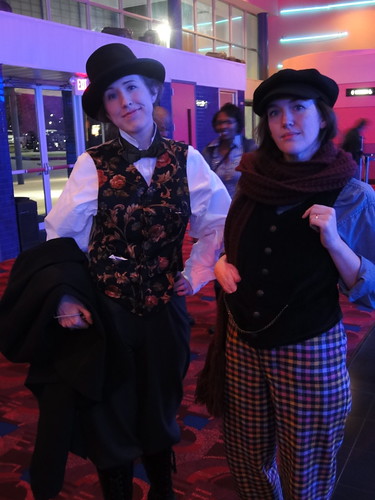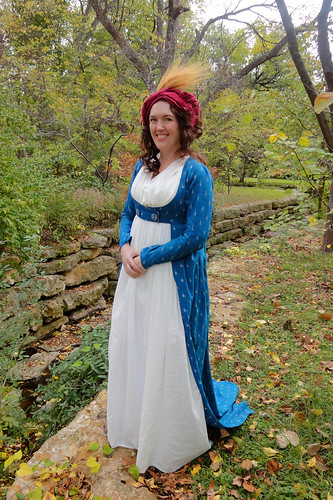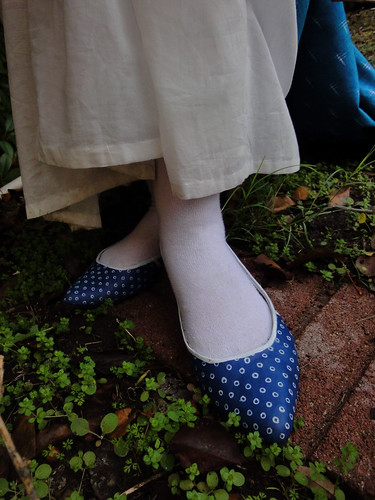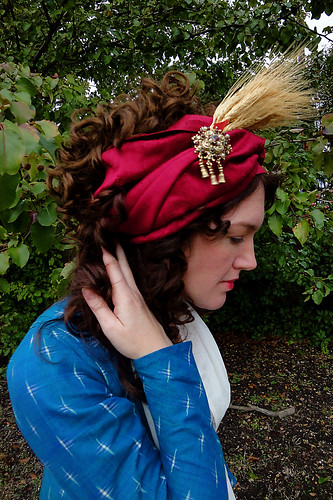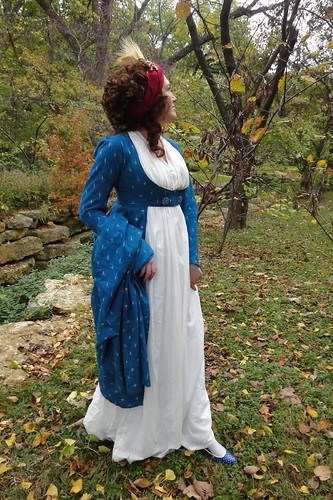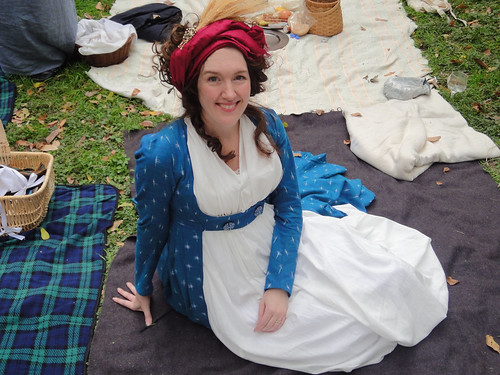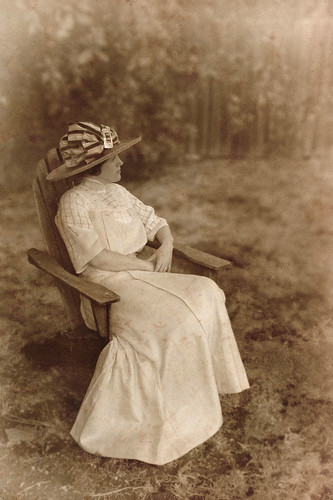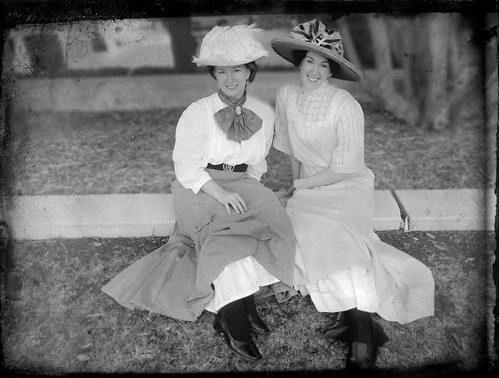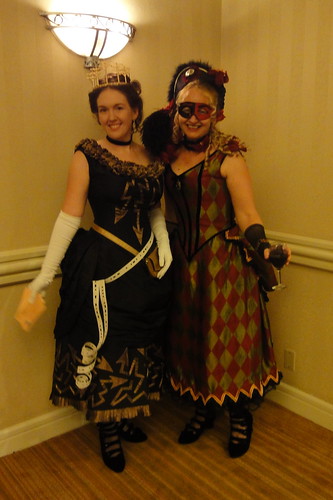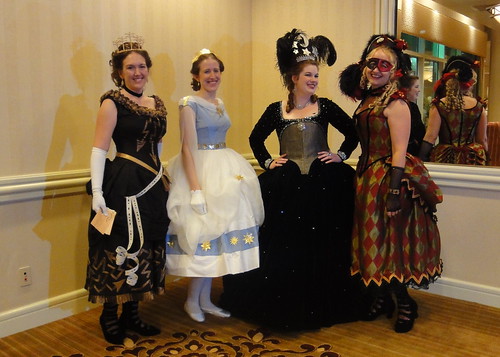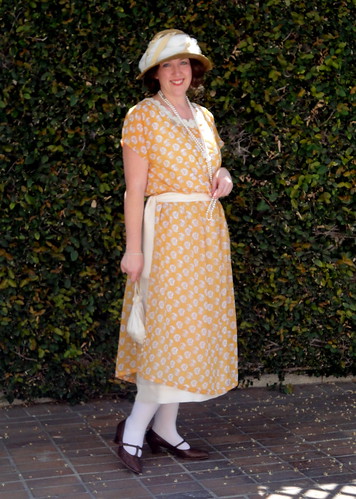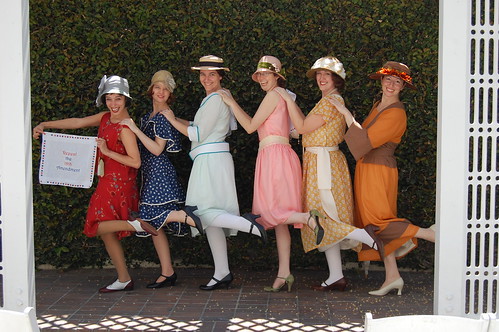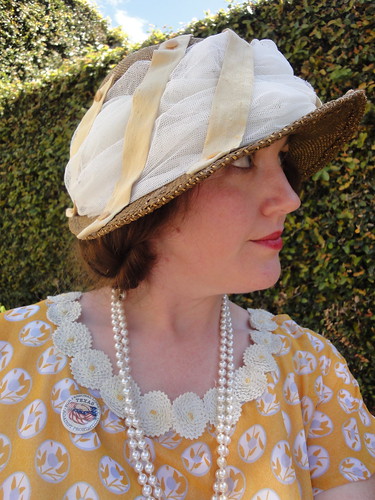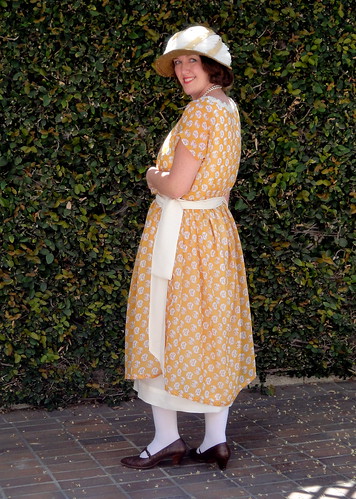Saturday, December 24, 2011
1910's corset pattern and instructions
In 2010, I wrote 2 articles for the online magazine Foundations Revealed about how I created a recreation of an antique corset from the mid-1910's. After a year on that site, I regained the rights to republish that article for free on my own website, so I thought I would share that with you all as a little holiday present from me! The original articles had more information about the research, pattern cloning techniques, and comparisons with the original garment, but I figured that people would be the most interested in the pattern and construction instructions, so this is a condensed version. This corset is a very easy garment to make up, and I hope this helps some of you with your 100 year Titanic anniversary and Downton Abbey costumes in 2012. Merry Christmas to you all! :)
Tuesday, December 20, 2011
a Sherlockian disguise
This past weekend, the DFWCG took a costumed outing to the newest Sherlock Holmes movie. Most of our members opted for Steampunk attire, but I was drawn toward something even more out of the ordinary for me. I had no desire to sit through a movie in a corset and bustle, so I decided to go as Irene Addler in disguise as a man. Although I don't think she would be very successful blending into a crowd if she wore pants like these!
I actually made the pants last year for an Alice in Wonderland party, but I was excited to get an excuse to wear them again. I have a mad love for obnoxious plaids, so in my very warped opinion, these are probably the most fabulous pants of all time! LOL! I made them with the discontinued Martha McCain Civil War pants pattern - Simplicity 5023. I thought they made up wonderfully, and I would definitely use that pattern again for the boys in my life if they ever need Victorian pants.
The vest was a bit of a train-wreck, and it fought me to the bitter end. Nothing fit together right, so I ended up ditching the collar and faced lining and turned it into a very dumbed-down version vs. something with authentic construction. I also accidentally cut off the underlap for the buttons, so it barely fit me when it was done. But luckily, it is made out of wide wale corduroy with a long pile, so black velvet-like fabric combined with a poorly lit theater hides a ton of flaws.
The shirt was just a cheap men's shirt from Walmart with the collar flap cut off to make it more of a band-collar style. The wool scarf is something that I wear all the time, and the newsy cap is something that I had from a previous Halloween costume.
It was such a fun costume to make and wear, and I love having an excuse to play with menswear for a change. And even better was that my friend Ginger dressed up as Irene Addler in disguise too, so I had some company with my cross-dressing shenanigans! The only problem is that it is hard to manage a "tough guy" face when you really want to smile and giggle and act silly with your friends! We'll have to work on that a bit! :)
I actually made the pants last year for an Alice in Wonderland party, but I was excited to get an excuse to wear them again. I have a mad love for obnoxious plaids, so in my very warped opinion, these are probably the most fabulous pants of all time! LOL! I made them with the discontinued Martha McCain Civil War pants pattern - Simplicity 5023. I thought they made up wonderfully, and I would definitely use that pattern again for the boys in my life if they ever need Victorian pants.
The vest was a bit of a train-wreck, and it fought me to the bitter end. Nothing fit together right, so I ended up ditching the collar and faced lining and turned it into a very dumbed-down version vs. something with authentic construction. I also accidentally cut off the underlap for the buttons, so it barely fit me when it was done. But luckily, it is made out of wide wale corduroy with a long pile, so black velvet-like fabric combined with a poorly lit theater hides a ton of flaws.
The shirt was just a cheap men's shirt from Walmart with the collar flap cut off to make it more of a band-collar style. The wool scarf is something that I wear all the time, and the newsy cap is something that I had from a previous Halloween costume.
It was such a fun costume to make and wear, and I love having an excuse to play with menswear for a change. And even better was that my friend Ginger dressed up as Irene Addler in disguise too, so I had some company with my cross-dressing shenanigans! The only problem is that it is hard to manage a "tough guy" face when you really want to smile and giggle and act silly with your friends! We'll have to work on that a bit! :)
Saturday, November 26, 2011
Georgian period toys
I LOVE making silly props to go with my silly costumes, and our Georgian picnic gives me the perfect opportunity to research and recreate 18th and early 19th c. toys and games every year.
The first new toy that we tried this year was the Chinese yo-yo, or diabolo (diable in French), which has proven a bit hard to research, but several online articles mention that it was called "devil on two sticks" in England, although they don't mention a source for that tidbit. But illustrations of adults and occasionally children playing with diabolos show up from time to time during this period, and I love how beautiful the people look while playing this game.

I first tried using a wooden diabolo that I ordered online from a English historical toy site. But even though the wooden diabolo looked like the illustrations, it was so lightweight and hard to work that even my friends who are jugglers and quite good at the diabolo had a hard time working with it.
So we switched over to a modern diabolo, and that worked much better. Cynthia, our resident diabolo expert, was able to give us lessons, and several people were able to able to get it going pretty well and even catch a few tosses after a bit of practice. But nobody did it with the same elegance and grace as Cynthia! Clearly, I need to buy a modern diabolo and spend the next 12 months practicing so I can do this next year. :)
I also brought a variety of small wooden toys, such as a top, cup and ball, and a yo-yo. The top and cup helped entertain the kids, but I really brought the yo-yo for the adults. I've always been charmed by this 1790's illustration of a woman playing with a yo-yo, which was known as a bandalore, l'emigrette, or quiz in the period. If internet articles are to believed, the yo-yo was a very popular toy for both adults and children in the late 18th c., especially among the nobility, and the action of the toy was equated with French nobility and their emigration out, then back in to the country during the French Revolution.
For my yo-yo, I simply bought a bamboo yo-yo from World Market, then painted it with concentric circles, which seems to be the most common form of decoration. Of course, French revolutionary colors seemed appropriate as well.
But the toy that I was the most excited about was my period kite. I used the instructions found on the PBS Ben Franklin website to make my kite, and I made it with handmade paper, linen ties on the tail, and I painted it with a simple triangle border, which was inspired by this 18th c. pear top kite. I was worried that it would never fly, but it actually worked pretty well! Although it was a bit unstable and really preferred to crash spectacularly into the ground, we did get it up to a nice cruising altitude one time, as seen in the photo at the top of this post.
I had a blast running back and forth down the clearing with my fellow kite enthusiast, Ginger, and we even drew quite a crowd of onlookers while we were flying it. It was a blast, and I can't wait to try it again next year!
I'm always looking for new period toy and games to keep us entertained at our events. We've also played Graces and battledore and shuttlecock in the past, and I'm hoping to try ninepins or lawn bowling next year (if I can find an affordable set). If you know of any other good Georgian games that can be played outdoors, I'd love to hear about them! And just for fun, check out this excellent site for other 18th century toys and games in period art.
1790's round gown and open robe
 The white round-gown worn under the open robe is a copy of this 1797 gown from Tidens Tøj. (the link is sadly broken now, but Aylwen has a screenshot of the pattern and her own beautiful photos of the dress on her blog. Thanks, Aylwen!) Although I was a bit intimidated by the pattern diagram at first, I was offered some help from dear friends translating the text, and it ended up going together beautifully. The sides and back of the bodice were covered with hand-sewn tucks that were mounted onto a linen foundation, and then the outer fabric was cut down to size. This was actually a really easy way to work, and I enjoyed having some mindless handy-work to keep me occupied during my lunch breaks. At times it seemed a bit silly to spend so much effort decorating a part of the dress that wouldn't even be seen, but hopefully, I'll find another occasion to wear the round gown on its own someday. The round gown is made up from some really lovely heirloom batiste that I got from Fabrique thanks to the gift card that I received from their remnant challenge last spring. Thanks again, Fabrique!
The white round-gown worn under the open robe is a copy of this 1797 gown from Tidens Tøj. (the link is sadly broken now, but Aylwen has a screenshot of the pattern and her own beautiful photos of the dress on her blog. Thanks, Aylwen!) Although I was a bit intimidated by the pattern diagram at first, I was offered some help from dear friends translating the text, and it ended up going together beautifully. The sides and back of the bodice were covered with hand-sewn tucks that were mounted onto a linen foundation, and then the outer fabric was cut down to size. This was actually a really easy way to work, and I enjoyed having some mindless handy-work to keep me occupied during my lunch breaks. At times it seemed a bit silly to spend so much effort decorating a part of the dress that wouldn't even be seen, but hopefully, I'll find another occasion to wear the round gown on its own someday. The round gown is made up from some really lovely heirloom batiste that I got from Fabrique thanks to the gift card that I received from their remnant challenge last spring. Thanks again, Fabrique!
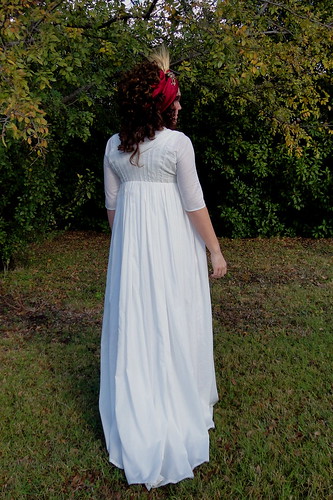
 The open robe is made from some ikat cotton that I bought fromHeritage Trading Company, which has GORGEOUS block-printed and ikat fabrics that are perfect for dresses from this period. I used the open robe pattern in Patterns of Fashion for the construction, and although it looked like it would be easy to put together, it actually turned out to be pretty difficult. My main problem is that I don't have a dress form that is my size, and this type of gown is draped to the body. I ended up using a dress form that was close, but not a true match, so I had to get dressed up over and over again so I could try it on and make modifications... which was tiresome. But I finally got it to work, and the way that the pleats are top-stitched to the lining means that it almost holds the shape of the body even when it isn't being worn, which is pretty cool. The only real modification that I made to the pattern is making the sleeves full length instead of 3/4, and I added some tri-color death's head buttons to the front cross-over as a bit of embellishment.
The open robe is made from some ikat cotton that I bought fromHeritage Trading Company, which has GORGEOUS block-printed and ikat fabrics that are perfect for dresses from this period. I used the open robe pattern in Patterns of Fashion for the construction, and although it looked like it would be easy to put together, it actually turned out to be pretty difficult. My main problem is that I don't have a dress form that is my size, and this type of gown is draped to the body. I ended up using a dress form that was close, but not a true match, so I had to get dressed up over and over again so I could try it on and make modifications... which was tiresome. But I finally got it to work, and the way that the pleats are top-stitched to the lining means that it almost holds the shape of the body even when it isn't being worn, which is pretty cool. The only real modification that I made to the pattern is making the sleeves full length instead of 3/4, and I added some tri-color death's head buttons to the front cross-over as a bit of embellishment.For the finishing touches, I decorated a pair of cheap Target flats with a white paint pen so they would have a pattern similar to these 1790's slippers. The vamp is a little low on these shoes compared to period examples, so I had planned on making some rosettes to cover that part up some more. Unfortunately, that was one of the only things that I didn't have time to get done, but I think they still work pretty good either way.
Here are a few more of my favorite pictures of my dress from the picnic, and you can see the full set on flickr. I'll be back to tell you about some of the cool 18th c. toys that we played with in my next post.
Labels:
1790s,
18th c.,
dfwcg,
georgian picnic,
regency
Sunday, October 30, 2011
Edwardian recap
Once again, I am horribly late when it comes to post-event blogging. *eek* Where does the time go!?! But back in mid-September, the costumers from the DFWCG had their semi-annual gathering at the Antique Elegance Show, and I whipped up a sunny linen gown to wear to it. I used two vintage 1910's patterns from my stash to make the dress, which was a ton of fun. It practically makes me giddy to use real 100 year old patterns to make something new! I really like the way this transitional style still has the slightly poochy bodice and A-line skirt of the Edwardian period, but it is combined with the short sleeves and streamlined shapes of the 1910's. It's a very fun style, and so easy to wear.
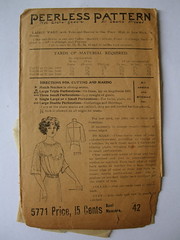
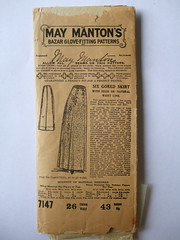
The body of the gown was made with a dollar's worth of estate sale linen, and the windowpane linen for the top of my bodice was a curtain from World Market that my husband brought home for free since it was damaged. The hat was also from an estate sale and only cost $2, and the ribbon is made from a decorator sample piece of silk that I also got from free. I did buy some vintage mother-of-pearl buttons for the back closure for $5, and the buckle on my hat cost around the same, but all together, the whole outfit cost me under $15, which might be a record for me. I love cheap costumes!
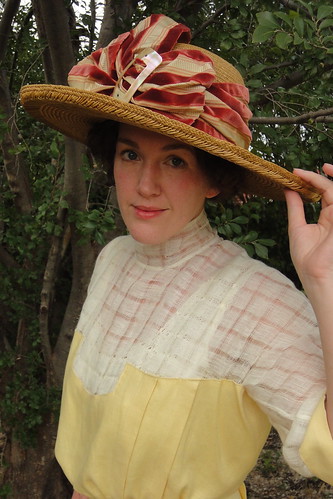
One of my favorite parts of this costume has to be my hat. It was vintage straw hat with a shallow crown that appeared to have come from some Asian country, but I stretched the crown to make it wider, and then cut it off and raised it a few inches to make it deeper. It still doesn't have the massive crown size that true Edwardian hats usually have, but at least it is closer now. I covered the extension in the crown with fabric pieced together to look like wide ribbon. I am proud to say that there is not one drop of hot glue in this hat, which might be a first for me!
The super-sheer fabric at the top of my dress scared the bejeezus out of me at first because I couldn't figure out if should line it or just let my undies show (*gasp!*) I eventually solved the problem by buying a pretty 1910's brassiere, and I just let it show through the fabric, which is exactly what the Edwardains would have done. I learned a ton about period brassieres in the process, and I even went on to write a two-part article about them for Foundations Revealed, which will come out in December and February. The first article covers the history of Edwardian/1910's brassieres, and the second one will teach you how to make one yourself based on the vintage brassiere that I am wearing with this outfit.
Other than being neck-deep in writing articles this past month, the other reason why this post is so late is because I really wanted to do some faux-vintage photos with some of the pictures that we took that weekend. I finally found some time to do that today, and I am really pleased with the results.
I've been experimenting with faux-vintage photography for years, but I now teach a digital photo class at work, and my Photoshop skills have improved drastically. I finally have some better skills for making the pictures do what I want. I figured out that the biggest issue is to try and duplicate the shallow depth of field that you see in old photographs where you have a blurry, light background and foreground. Modern point-and-shoot cameras try to keep everything in focus, and it's a dead giveaway that the the faux-effect is a fake. It's amazing what a difference that makes! I also have some more sophisticated photoshop actions to create the sepia look now, and I overlaid the photo with a scan of paper foxing to give it a slightly speckled look. Here are a few original pictures that I was looking at for comparison when making my photo.
I also tried my hand at copying the look of a different style of period photography, inspired by this fun picture of two Edwardian ladies showing a bit of ankle. (oh-la-la!) I didn't have a suitable glass plate frame to use around the picture, so I used one of my scanned tin-types for the border instead. It gives it a slightly different look, and I don't think this fake is as convincing as the other, but I still like the results. My friend Christy and I had entirely too much fun posing for this picture!
You can see the rest of my flickr set from this event here.
Labels:
1910's,
dfwcg,
photography
Sunday, September 11, 2011
Edwardian Collar Stays
Now that I have finally caught up with blogging about my finished costumes from this summer, I can once again turn my attention to current and future projects. At the moment, I am finishing up an early-1910's dress that I am making to wear to the Antique Elegance show next weekend. I've really learned a lot with this project, and I've had fun trying out some period techniques that are new to me.
The bodice that I am making has a tall collar, and I knew that it would need some support to keep it from wrinkling or sliding down. The only problem is that my fabric is a very sheer windowpane linen, so I didn't want to use thick boning channels that would detract from the delicate fabric. So what did women in the 1910's use to solve this problem? A quick search on Etsy turned up this lovely card of antique collar stays, so I snatched them up for "research" purposes. Don't you love shopping for a good cause. :)
The card of stays was so beautiful and pristine that I wouldn't dream of using the originals for my dress, but at least I could measure them and figure out how they were made. The wire is stiff, but still bendable, and it is covered with white silk. It seemed very similar to millinery wire, so I drug out some of my own millinery wire and decided to give it a try. It was very easy to bend the wire into a serpentine shape, but the thread covering would become frizzy or broken if I bent it with any type of pliers. The thread didn't break if I bent it with my fingers instead of the pliers, but I couldn't get the curves in the wire as perfect that way. I wonder if my threads were breaking because my millinery wire is so old (it came from an estate sale) or if it would do the same thing with modern wire.
When I started looking more closely at the antique collar stays, I couldn't see thread wrapped around the wires as I originally assumed. They feel more solid and smooth - almost like they are wrapped in silk paper instead of thread. I'm not sure if wire like that even exists anymore, but it made me wonder if you could paint millinery wire with a layer of flexible glue, like Sobo or Elmer's, to seal the threads together before bending them. I haven't tried this yet, but it might be worth a try if any of you are considering making wire collar stays of your own.
The original collar stays were 3" long, but the card lists other sizes that they came in. I made mine be 2 1/2" and 2" long to fit my collar better. Even though my reproduction collar stays are not as pretty as the original ones, they still work wonderfully. I can't feel them at all when wearing the dress, and they blend in with the sheer fabric very well.
The bodice that I am making has a tall collar, and I knew that it would need some support to keep it from wrinkling or sliding down. The only problem is that my fabric is a very sheer windowpane linen, so I didn't want to use thick boning channels that would detract from the delicate fabric. So what did women in the 1910's use to solve this problem? A quick search on Etsy turned up this lovely card of antique collar stays, so I snatched them up for "research" purposes. Don't you love shopping for a good cause. :)
The card of stays was so beautiful and pristine that I wouldn't dream of using the originals for my dress, but at least I could measure them and figure out how they were made. The wire is stiff, but still bendable, and it is covered with white silk. It seemed very similar to millinery wire, so I drug out some of my own millinery wire and decided to give it a try. It was very easy to bend the wire into a serpentine shape, but the thread covering would become frizzy or broken if I bent it with any type of pliers. The thread didn't break if I bent it with my fingers instead of the pliers, but I couldn't get the curves in the wire as perfect that way. I wonder if my threads were breaking because my millinery wire is so old (it came from an estate sale) or if it would do the same thing with modern wire.
When I started looking more closely at the antique collar stays, I couldn't see thread wrapped around the wires as I originally assumed. They feel more solid and smooth - almost like they are wrapped in silk paper instead of thread. I'm not sure if wire like that even exists anymore, but it made me wonder if you could paint millinery wire with a layer of flexible glue, like Sobo or Elmer's, to seal the threads together before bending them. I haven't tried this yet, but it might be worth a try if any of you are considering making wire collar stays of your own.
The original collar stays were 3" long, but the card lists other sizes that they came in. I made mine be 2 1/2" and 2" long to fit my collar better. Even though my reproduction collar stays are not as pretty as the original ones, they still work wonderfully. I can't feel them at all when wearing the dress, and they blend in with the sheer fabric very well.
Saturday, September 10, 2011
Telegraph fancy dress
Wow, I am getting so behind on my costume posts! I started this entry a month ago, but I'm just now finding the time to finish it. Now that school is back in session, I'm hoping that things start settling down a little bit and I can keep up with all of my online projects a little better. Fingers crossed...
The other new costume that I made for Costume College this summer was my gala dress, which was an 1885 fancy dress costume (like a for masquerade ball) representing the telegraph. This is one of the most bizarre costumes that I've ever made, but also one of the most fun. I wish I could take credit for the zany design of this dress, but other than a few minor modifications, I just tried to copy the fashion plate as closely as possible.
The dress is made out of silk taffeta, and the gold arrows and ruffles are made out of silk/metal organza. For the bodice, I used one of the ball gown bodice patterns in Fashion of the Gilded Age where you use the little apportioning rulers to create a custom fit. It worked fabulously, and I made sure to keep a good copy of this pattern for future use. The foundation skirt is from Patterns of Fashion, and both the bodice and foundation skirt are flat lined with cotton calico to give them more structure. I also boned all of the seams in the bodice, which is something that I don't usually do, and it really helped to create a smooth fit. All of the arrows are machine appliqued using gold thread, and although that part was pretty time-consuming, I actually had a lot of fun doing it. The decorative treatment around the neckline was made by running gathering stitches across a super-long strip of the gold fabric, and then tacking the gathered parts to the bodice to create puffs.
This is only the 3rd bustle dress that I've ever made, and I while I think I did pretty good with the foundation skirt and the bodice, the overskirt was less to my liking. I tried to just drape something on my own at the very last minute, but looking at pictures now, I'm disappointed with how flat it looks in back. If I ever have an excuse to wear it again, I'm definitely going to take the overskirt apart and try a different bustling technique. Luckily, all that black fabric hides a lot of flaws, so I don't think it was too obvious to anybody other than me that the overskirt didn't live up to my expectations.
For the accessories, I made a faux-leather pouch that I sprayed with a little gold spray paint to give it a bit of a shimmer. The pouch closes with an antique telegraph messenger button that also has zig-zag arrows on it, which I'm sure nobody would ever notice in real life, but details like that always make me happy. I also made some morse code tape to wear around my waist out of brown paper tape that was folded in half and glued. Then I painted it white and punched a message into the paper tape with a hole puncher. Of course I had to entertain myself while doing all of that punching, so one of the things that it says is "tonight we're gonna party like it's 1885". ;) And finally, I found some online examples of real telegraph envelopes from the Victorian period, and I made my own reproductions to carry around in my messenger pouch to use as a prop.
I only thing that I didn't like in the original illustration was the kooky headdress made out of one of those glass telegraph pole insulators. I love silly hats, but that was even too weird for me to get into! So I decided to make a telegraph tiara using model train telephone poles and a very simple bridal tiara. I sawed the poles to the right lengths, super-glued them to the tiara, strung the poles with gold wire, and then spray painted the whole thing with gold paint.
So that's about it! I am totally hooked on Victorian masquerade costumes now, and I hope I get a chance to make another one in the future. The most fun part of this whole project was getting to wear my costume with other fancy dress people at the Costume College Time Traveler's Gala. I love dressing in themed groups, and we had quite a ball at the ball!
The other new costume that I made for Costume College this summer was my gala dress, which was an 1885 fancy dress costume (like a for masquerade ball) representing the telegraph. This is one of the most bizarre costumes that I've ever made, but also one of the most fun. I wish I could take credit for the zany design of this dress, but other than a few minor modifications, I just tried to copy the fashion plate as closely as possible.
This is only the 3rd bustle dress that I've ever made, and I while I think I did pretty good with the foundation skirt and the bodice, the overskirt was less to my liking. I tried to just drape something on my own at the very last minute, but looking at pictures now, I'm disappointed with how flat it looks in back. If I ever have an excuse to wear it again, I'm definitely going to take the overskirt apart and try a different bustling technique. Luckily, all that black fabric hides a lot of flaws, so I don't think it was too obvious to anybody other than me that the overskirt didn't live up to my expectations.
For the accessories, I made a faux-leather pouch that I sprayed with a little gold spray paint to give it a bit of a shimmer. The pouch closes with an antique telegraph messenger button that also has zig-zag arrows on it, which I'm sure nobody would ever notice in real life, but details like that always make me happy. I also made some morse code tape to wear around my waist out of brown paper tape that was folded in half and glued. Then I painted it white and punched a message into the paper tape with a hole puncher. Of course I had to entertain myself while doing all of that punching, so one of the things that it says is "tonight we're gonna party like it's 1885". ;) And finally, I found some online examples of real telegraph envelopes from the Victorian period, and I made my own reproductions to carry around in my messenger pouch to use as a prop.
I only thing that I didn't like in the original illustration was the kooky headdress made out of one of those glass telegraph pole insulators. I love silly hats, but that was even too weird for me to get into! So I decided to make a telegraph tiara using model train telephone poles and a very simple bridal tiara. I sawed the poles to the right lengths, super-glued them to the tiara, strung the poles with gold wire, and then spray painted the whole thing with gold paint.
So that's about it! I am totally hooked on Victorian masquerade costumes now, and I hope I get a chance to make another one in the future. The most fun part of this whole project was getting to wear my costume with other fancy dress people at the Costume College Time Traveler's Gala. I love dressing in themed groups, and we had quite a ball at the ball!
Labels:
1880's,
fancy dress
Saturday, August 6, 2011
20's convert
I'm home from my big trip to Costume College in California, and I finally have a little bit of time for blogging again. Hooray! I had meant to do some diaries about the outfits that I was making over the summer, but I ended up running so short on time that I had to keep myself off the computer as much as possible.
So the first new outfit that I'm going to tell you about is my early 1920's dress that I made to go along with a group of ladies who were all dressing up in prohibition-era attire. Let me preface this by stating that the 1920's are some my my least favorite fashions ever, and I NEVER thought I'd find a 20's style that looked good on me. The dress that I ended up with was actually my third try at making a prohibition-era costume this summer, but I am so happy that I stuck with it and kept looking for something that I could live with because I had a blast with the group, and I love the way my dress turned out!
I decided to focus on early 20's styles since I like that the waists were still defined earlier in the decade, and I prefer the fuller skirts to the more severe styles that you see later in the 20's. So I was thrilled when I came across this wonderful vintage pattern on etsy that was in my price range. It wasn't dated, but I am guessing from the style that it is from around 1921.
I looked around for a while trying to find some lace or net that I could use for a version like you see in View A, but when that failed, I decided to use a patterned silk crepe that had a vaguely art deco feel to it. The underdress and sash are made out of georgette, and I used vintage ric-rack rosettes around the neckline to add a little decoration. I didn't use the over-tunic on the blouse, but other than that, I made the pattern up exactly as it came, and it fit wonderfully with no alterations.
I think the best part about 20's fashions are the accessories, so I knew that I needed a hat to finish off the look. Wide brim hats were more popular in the early 20's than the cloche styles that we usually associate with that decade, so I took a wide brim straw hat and stretched the crown over a hat block so it would sit further down on my head, then I cut the brim down to a more medium size. I was wasn't really sure what direction I wanted to go with decorating this thing, but since I was running short on time, I ended up just wrapping the crown with net and adding some silk strips with vintage buttons to add some color and visual interest. It's really random and a bit sloppy, but a lot of early 20's hats look very random and homemade, so I figured, "hey, why not? It's period!" I also made a reproduction of an antique anti-prohibition button that I found online. It says "Texas - For Personal Liberty, Against Prohibition". I thought it was cute, and I am a sucker for anything that says Texas on it. I also wore a super-long strand of pearls that I found at an estate sale, a pair of T-strap shoes from etsy, and my Edwardian purse that goes with everything.
This was a delightful costume to wear - especially after being in non-stop corsets for the two previous days. I can TOTALLY see why women wore these fashions now. They must have felt amazing after decades of more restrictive clothing. I hate to admit it, but I think I'm a 20's convert now! ;)
Labels:
1920's,
vintage patterns


